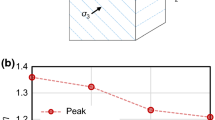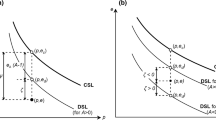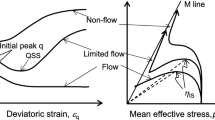Abstract
A unified hypoplastic model is formulated by incorporating the anisotropic critical state theory to describe the fabric effect in sand under both monotonic and cyclic loading conditions. An evolving deviatoric fabric tensor that characterizes the internal microstructure of sand is introduced into the hypoplastic model in conjunction with the intergranular strain concept. A scalar-valued fabric anisotropic variable indicating the interplay between the fabric and the loading direction is employed to account for the impact of fabric anisotropy on both the dilatancy and shear strength of sand. The model is demonstrated to be capable of simulating the anisotropic behavior of sand, using a single set of parameters under both monotonic and cyclic loading conditions, as evidenced by the satisfactory match with experimental results from various sources. In particular, by considering the influence of fabric evolution on the dilatancy of sand, the model adequately accounts for the fabric change effect and accurately captures the deviatoric strain accumulation, cyclic mobility, and the flow liquefaction phenomenon under cyclic loading condition.
























Similar content being viewed by others
References
Abelev A, Lade PV (2004) Characterization of failure in cross-anisotropic soils. J Eng Mech 130(5):599–606
Atkinson JH, Richardson D, Stallebrass S (1990) Effect of recent stress history on the stiffness of overconsolidated soil. Géotechnique 40(4):1–540
Azami A, Pietruszczak S, Guo P (2010) Bearing capacity of shallow foundations in transversely isotropic granular media. Int J Numer Anal Methods Geomech 34:771–793
Bauer E (1996) Calibration of a comprehensive hypoplastic model for granular materials. Soils Found 36(1):13–26
Bauer E, Huang W, Wu W (2004) Investigations of shear banding in an anisotropic hypoplastic material. Int J Solids Struct 41:5903–5919
Been K, Jefferies MG (1985) A state parameter for sands. Géotechnique 35(2):99–112
Dafalias YF, Manzari MT (2004) Simple plasticity sand model accounting for fabric change effects. J Eng Mech 130(6):622–634
Dafalias YF, Papadimitriou AG, Li XS (2004) Sand plasticity model accounting for inherent fabric anisotropy. J Eng Mech 130(11):1319–1333
Dafalias YF, Popov EP (1975) A model of nonlinearly hardening materials for complex loading. Acta Mech 21(3):173–192
Fonseca J, O’Sullivan C, Coop MR (2013) Quantifying the evolution of soil fabric during shearing using directional parameters. Géotechnique 63(6):487–499
Fuentes W, Wichtmann T, Gil M, Lascarro C (2019) ISA-hypoplasticity accounting for cyclic mobility effects for liquefaction analysis. Acta Geotech 15:1513–1531
Gao ZW, Zhao JD (2015) Constitutive modeling of anisotropic sand behavior in monotonic and cyclic loading. J Eng Mech 141(8):04015017
Gao ZW, Zhao JD, Li XS, Dafalias YF (2014) A critical state sand plasticity model accounting for fabric evolution. Int J Numer Anal Methods Geomech 38(4):370–390
Gudehus G (1996) A comprehensive constitutive equation for granular materials. Soils Found 36(1):1–12
Herle I, Gudehus G (1999) Determination of parameters of a hypoplastic constitutive model from properties of grain assemblies. Mech Cohesive Frict Mater 4(5):461–486
Ishihara K, Tatsuoka F, Yasuda S (1975) Undrained deformation and liquefaction of sand under cyclic stresses. Soils Found 15(1):29–44
Ishihara K, Yamazaki F (1980) Cyclic simple shear tests on saturated sand in multi-directional loading. Soils Found 20(1):45–59
Iwan WD (1967) On a class of models for the yielding behavior of continuous and composite systems. J Appl Mech 34(3):612–617
Jardine RJ, Symes MJ, Burland JB (1984) The measurement of soil stiffness in the triaxial apparatus. Géotechnique 34:323–340
Kimura T, Kusakabe O, Saitoh K (1985) Geotechnical model tests of bearing capacity problems in a centrifuge. Géotechnique 35(1):33–45
Kirkgard MM, Lade PV (1993) Anisotropic three-dimensional behavior of a normally consolidated clay. Can Geotech J 30(4):848–858
Kolymbas D (1991) An outline of hypoplasticity. Arch Appl Mech 3(61):143–151
Krieg RD (1975) A practical two-surface plasticity theory. J Appl Mech 42:641–646
Kuhn MR, Renken HE, Mixsell AD, Kramer SL (2014) Investigation of cyclic liquefaction with discrete element simulations. J Geotech Geoenviron Eng 140(12):04014075
Li X, Li XS (2009) Micro–macro quantification of the internal structure of granular materials. J Eng Mech 135(7):641–656
Li XS (2002) A sand model with state-dependent dilatancy. Géotechnique 52(3):173–186
Li XS, Dafalias YF (2002) Constitutive modeling of inherently anisotropic sand behavior. J Geotech Geoenviron Eng 128(10):868–880
Li XS, Dafalias YF (2012) Anisotropic critical state theory: role of fabric. J Eng Mech 138(3):263–275
Li XS, Dafalias YF (2000) Dilatancy for cohesionless soils. Géotechnique 50(4):449–460
Manzari MT, Dafalias YF (1997) A two-surface critical plasticity model for sand. Géotechnique 47(2):255–272
Masson S, Martinez J (2001) Micromechanical analysis of the shear behavior of a granular material. J Eng Mech 127(10):1007–1016
Mroz Z (1967) On the description of anisotropic work hardening. J Mech Phys Solids 15:163–175
Mroz Z, Norris VA, Zienkiewicz OC (1978) An anisotropic hardening model for soils and its application to cyclic loading. Int J Numer Anal Methods Geomech 2:203–221
Nakata Y, Hyodo M, Murata H, Yasufuku N (1998) Flow deformation of sands subjected to principal stress rotation. Soils Found 38(2):115–128
Nemat-Nasser S (1980) On behavior of granular material in simple shear. Soils Found 20(3):59–73
Nemat-Nasser S, Tobita Y (1982) Influence of fabric on liquefaction and densification potential of cohesionless sand. Mech Mater 1:43–62
Niemunis A, Herle I (1997) Hypoplastic model for cohesionless soils with elastic strain range. Mech Cohesive Frict Mater 2(4):279–299
Oda M (1984) Distribution of directional data and fabric tensors. Int J Eng Sci 22(2):49–164
Oda M (1972) The mechanism of fabric changes during compressional deformation of sand. Soils Found 12(2):1–18
Oda M, Kawamoto K, Suzuki K, Fujimori H, Sato M (2001) Microstructural interpretation on reliquefaction of saturated granular soils under cyclic loading. J Geotech Geoenviron Eng 127(5):416–423
Oda M, Koishikawa I (1979) Effect of strength anisotropy on bearing capacity of shallow footing in a dense sand. Soils Found 19(3):15–28
Oda M, Koishikawa I, Higuchi T (1978) Experimental study of anisotropic shear strength of sand by plane strain test. Soils Found 18(1):25–38
Pan K, Xu TT, Liao D, Yang ZX (2020) Failure mechanisms of sand under asymmetrical cyclic loading conditions: experimental observation and constitutive modelling. Géotechnique. https://doi.org/10.1680/jgeot.20.P.004
Papadimitriou AG, Dafalias YF, Yoshimine M (2005) Plasticity modeling of the effect of sample preparation method on sand response. Soils Found 45(2):109–123
Petalas AL, Dafalias YF, Papadimitriou AG (2018) SANISAND-FN: an evolving fabric-based sand model accounting for stress principal axes rotation. Int J Numer Anal Methods Geomech 43(1):97–123
Prevost JH (1977) Mathematical modeling of monotonic and cyclic undrained clay behavior. Int J Numer Anal Methods Geomech 1(2):195–216
Qiu G, Henke S, Grabe J (2011) Application of a coupled Eulerian–Lagrangian approach on geomechanical problems involving large deformations. Comput Geotech 38(1):30–39
Roscoe KH, Schofield A, Wroth CP (1958) On the yielding of soils. Géotechnique 8(1):22–53
Schofield AN, Wroth CP (1968) Critical state soil mechanics. McGraw-Hill, London
Sitharam TG (2003) Discrete element modelling of cyclic behaviour of granular materials. Geotech Geol Eng 21(4):297–329
Soroush A, Ferdowsi B (2011) Three dimensional discrete element modeling of granular media under cyclic constant volume loading: a micromechanical perspective. Powder Technol 212(1):1–16
Sriskandakumar S (2004) Cyclic loading response of Fraser River sand for validation of numerical models simulating centrifuge tests. M.S. thesis. University of British Columbia, Vancouver, BC, Canada
Tejchman J, Bauer E, Wu W (2007) Effect of fabric anisotropy on shear localization in sand during plane strain compression. Acta Mech 189:23–51
Theocharis AI, Vairaktaris E, Dafalias YF, Papadimitriou AG (2019) Necessary and sufficient conditions for reaching and maintaining critical state. Acta Geotech 43(12):2041–2055
Theocharis AI, Vairaktaris E, Dafalias YF, Papadimitriou AG (2017) Proof of incompleteness of critical state theory in granular mechanics and its remedy. J Eng Mech 143(2):04016117
Uthayakumar M, Vaid YP (1998) Static liquefaction of sands under multiaxial loading. Can Geotech J 35:273–283
Vaid YP, Chern JC, Tumi H (1985) Confining pressure, grain angularity, and liquefaction. J Geotech Geoenviron Eng 111(10):1229–1235
von Wolffersdorff PA (1996) A hypoplastic relation for granular materials with a predefined limit state surface. Mech Cohesive Frict Mater 1(3):251–271
Wang G, Xie YN (2014) Modified bounding surface hypoplasticity model for sands under cyclic loading. J Eng Mech 140(1):91–101
Wang R, Fu PC, Zhang JM, Dafalias YF (2016) Dem study of fabric features governing undrained post-liquefaction shear deformation of sand. Acta Geotech 11(6):1321–1337
Wang S, Wu W (2020) A simple hypoplastic model for overconsolidated clays. Acta Geotech. https://doi.org/10.1007/s11440-020-01000-z
Wang S, Wu W, Peng C, He XZ, Cui DS (2018) Numerical integration and FE implementation of a hypoplastic constitutive model. Acta Geotech 13(6):1265–1281
Wang S, Wu W, Yin ZY, Peng C, He XZ (2018) Modelling the time-dependent behavior of granular material with hypoplasticity. Int J Numer Anal Methods Geomech 42(12):1331–1345
Wang ZL, Dafalias YF, Shen CK (1990) Bounding surface hypoplasticity model for sand. J Eng Mech 116(5):983–1001
Wichtmann T, Triantafyllidis T (2016) An experimental database for the development, calibration and verification of constitutive models for sand with focus to cyclic loading: part I—tests with monotonic loading and stress cycles. Acta Geotech 11:739–761
Wichtmann T, Triantafyllidis T (2016) An experimental database for the development, calibration and verification of constitutive models for sand with focus to cyclic loading: part II—tests with strain cycles and combined loading. Acta Geotech 11:763–774
Woo SI, Salgado R (2015) Bounding surface modeling of sand with consideration of fabric and its evolution during monotonic shearing. Int J Solids Struct 63:277–288
Wu W (1998) Rational approach to anisotropy of sand. Int J Numer Anal Methods Geomech 22(11):921–940
Wu W, Bauer E (1994) A simple hypoplastic constitutive model for sand. Int J Numer Anal Methods Geomech 18(12):833–862
Wu W, Kolymbas D (1990) Numerical testing of the stability criterion for hypoplastic constitutive equations. Mech Mate 9(3):245–253
Wu W, Bauer E, Kolymbas D (1996) Hypoplastic constitutive model with critical state for granular materials. Mech Mater 23(1):143–163
Xu GF, Peng C, Wu W, Qi JL (2017) Combined constitutive model for creep and steady flow rate of frozen soil in an unconfined condition. Can Geotech J 54(7):907–914
Yang ZX, Li XS, Yang J (2008) Quantifying and modelling fabric anisotropy of granular soils. Géotechnique 58(4):237–248
Yang ZX, Liao D, Xu TT (2019) A hypoplastic model for granular soils incorporating anisotropic critical state theory. Int J Numer Anal Methods Geomech 44(6):723–748
Yang ZX, Wu Y (2017) Critical state for anisotropic granular materials: a discrete element perspective. Int J Geomech 17(2):81–92
Yang ZX, Xu TT, Chen YN (2018) Unified modeling of the influence of consolidation conditions on monotonic soil response considering fabric evolution. J Eng Mech 144(8):04018073
Yang ZX, Zhao CF, Xu CJ, Wilkinson SP, Cai YQ, Pan K (2016) Modelling the engineering behaviour of fibrous peat formed due to rapid anthropogenic terrestrialization in Hangzhou, China. Eng Geol 215:2–35
Yoshimine M, Ishihara K, Vargas W (1998) Effects of principal stress direction and intermediate principal stress on undrained shear behavior of sand. Soils Found 38(3):179–188
Zhao JD, Guo N (2013) Unique critical state characteristics in granular media considering fabric anisotropy. Géotechnique 63(8):695–704
Acknowledgements
The research described in the paper was funded by the National Key R&D program of China under Grant 2016YFC0800200 and the Natural Science Foundation of China under Grant Nos. 51825803 and 52020105003.
Author information
Authors and Affiliations
Corresponding author
Additional information
Publisher's Note
Springer Nature remains neutral with regard to jurisdictional claims in published maps and institutional affiliations.
Rights and permissions
About this article
Cite this article
Liao, D., Yang, Z.X. Hypoplastic modeling of anisotropic sand behavior accounting for fabric evolution under monotonic and cyclic loading. Acta Geotech. 16, 2003–2029 (2021). https://doi.org/10.1007/s11440-020-01127-z
Received:
Accepted:
Published:
Issue Date:
DOI: https://doi.org/10.1007/s11440-020-01127-z




